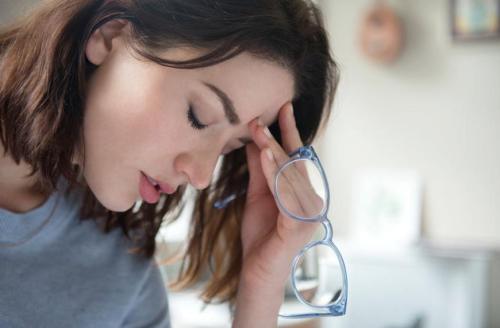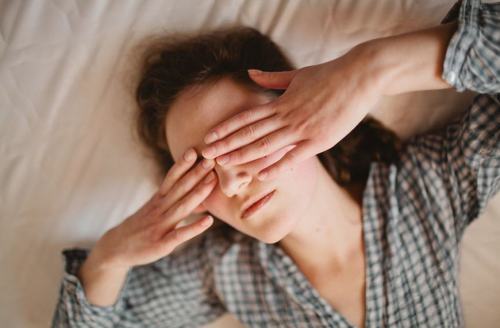Your desk job might be causing your horrible headaches—here’s how to deal
We all spend a ton of time in front of screens (whether it's computers, smartphones, or TVs). But that habit might cause eye strain headaches.

Advancements in technology have brought us some amazing things, like space travel, Jennifer Garner’s Instagram account, and dog memes. But because of all these tech advances, we’re also spending a lot more time in front of computer and phone screens (like, a lot. That Screen Time app is terrifying.)
Some of the time spent computer-side is necessary—can you even imagine if I had to turn this article into my editor via typewriter and snail mail?—but overall most of us spend a lot of time looking at various screens. And the resulting eye strain could be the culprit behind your recurring headaches.
“These days, we’re using smart phones, tablets and computers more and more, which means eye strain-related headaches are becoming increasingly more common than they ever were before,” says Waldo’s in-house optician, Anita Mistry. But knowing whether or not you have one can be the tricky part.

What is eye strain, exactly?
You know how when you’re at work trying to focus on a big project, and people keep interrupting you and asking you to do other stuff that is technically part of your job—but stresses you TF out because now you have a ton of things you have to get done all at once? That’s basically what you’re asking your eyes to do when you spend hours working at your computer or scrolling through IG stalking your ex. You’re likely not just staring at one page for a while, but also switching between tabs (shoutout to the people who have 30 tabs open right now) and apps and looking over at your notepad.
Yes, this seems like normal behavior, but it’s actually really stressful for your eyes. The constant shifting of gears means they always have to refocus, which puts added pressure on them. Plus, “when working at a computer, we tend not to blink,” Mistry says. “This causes eyes to dry out, which can cause eye strain and headaches.”
And while screen time plays a big role in modern eye strain, there are other things you do that could stress out your eyes. Intensive work, like reading a lot or straining your eyes to see small print, can also contribute to eye strain. Working in poor light is another common cause, as are things like stress and lack of sleep, per the Mayo Clinic. Even driving long distances without a break (where you’re focusing on just the road for long periods of time) can lead to eye strain.
How can you tell if you have an eye strain headache?
Headaches can be brought on by a variety of things, from drinking too much wine (been there) to stress to lack of sleep, according to the Mayo Clinic. So how can you tell if your headache is eye strain-related? “The easiest way to check if your headaches are related to eye strain is to assess when and where you experience your headaches,” Mistry says. “If you experience them during or after being at a computer for long periods of time, working in dimly lit conditions, or using your eyes intensively, your headache is likely to be related to eye strain.”
She also adds that sore, tired eyes accompanying a headache in the back of the neck, temples, or forehead is basically a dead giveaway of an eye strain headache. (Sound familiar?)
How can you prevent them from happening?
In an ideal world, we’d be able to spend more time away from our screens. But short of quitting your job and living under a computer-free rock, completely cutting out your screens is basically impossible. Instead, Mistry says to take eye breaks every 20 minutes. What this looks like: Look away from your computer screen and focus on something in the distance. Then hold your thumb in your line of sight and focus on your thumb, then focus on something in the distance, then back at your thumb. Do this around five times. You might get some side-eye from your coworkers, but your own eyes will thank you.
She also recommends increasing the font size on your computer and turning up the brightness to help out your eyes instead of squinting and straining to see the teeny-tiny font in your emails. Keep eye drops handy as well to help alleviate dryness that comes from staring at your computer screen and not blinking enough.
Thankfully, eye strain is usually temporary and goes away once you rest your eyes a bit. If rest is not giving you any relief, you should see a doc—since the eye strain might be the result of an underlying condition like uncorrected vision that should be addressed.
Yes, eye strain-related headaches are annoying, but in the process of researching this story I found out that there’s such a thing as sex headaches and, TBH, that sounds a lot worse. It’s all about perspective.
Hey! Your ponytail could also be causing your headaches. Here’s what to do. Plus, 6 foods and drinks that can help alleviate headache pain.
Sign Up for Our Daily Newsletter
Get all the latest in wellness, trends, food, fitness, beauty, and more delivered right to your inbox.
Got it, you've been added to our email list.










